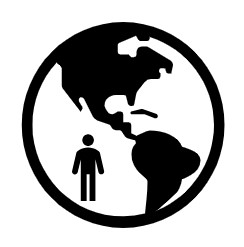 Positionality and Positionality Statements in Teaching
Positionality and Positionality Statements in Teaching
Jackie Broussard (2022), writing for Verto Education, defines positionality as “where we stand in relation to dynamics of power and privilege” (para. 2). She continues and claims that positionality is also the set of identities we possess, such as race, class, gender, and religion, and how these identities influence and color our views (Broussard, 2022).
Broussard writes from the perspective of a college student preparing for a semester abroad, advocating that students should be aware of their positionality before they travel and engage with other peoples and cultures. “A crucial part of becoming a global citizen is being self-aware and cognizant of the effect our presence has on our environment” (Broussard, 2022, para. 3).
Positionality has become an important consideration in the world of research in recent years. Jacobson and Mustafa (2019) write, “The way that we, as researchers view and interpret our social worlds, is impacted by where, when, and how we are socially located and in what society” (p. 1). It is recognized “that the way that researchers perceive the social world is largely dependent on their position within it” (Jacobson & Mustafa, 2019, p. 2). Like college students preparing to go abroad, responsible researchers become cognizant of their positionality, which can also be seen as an aspect of global citizenship.
Arguably, practicing positionality is something that professors should explore as well. By doing so, instructors can make a stronger connection to their students, and stronger relationships between faculty and students yield better learning outcomes (Kuh et al., 20026). This kind of reflection is not easy, however. Indeed, it can be a daunting exercise. “We argue that continuously developing a better understanding of our positionality and how it may impact our work is no simple or straightforward task” (Jacobson & Mustafa, 2019, p. 2). However, the outcomes are well worth the trial. Like with researchers, practicing positionality allows faculty to become aware of their biases. “In social contexts, understanding our own positionality can help us confront our own biases. By acknowledging the limitations of our own viewpoints and experiences, we can create space for the inclusion of others and actively seek out new information” (University of Michigan, 2021, para. 9). For faculty, the others they want to include are their students.
Jacobson and Mustafa (2019) have developed a tool known as the Social Identity Map for outlining positionality. It is a branching graphic organizer which can be filled in with one’s identities. In their article Social Identity Map: A Reflexivity Tool for Practicing Explicit Positionality in Critical Qualitative Research, they argue that this tool can be used to concretize this abstract concept. For those who have never explored their positionality, doing so the first time may prove challenging, and Jacobson and Mustafa claim the Social Identity Map can help. This tool would also be useful for developing a positionality statement.
A positionality statement is a declaration of the identities one has and how those identities most likely influence that individual. Effective positionality statements generally include information about race, social class, religion, career, and beliefs (Darwin Holmes, 2020). For faculty, including a positionality statement on their syllabus is conducive to building an inclusive and welcoming classroom. A positionality statement on a syllabus communicates that the instructor is human and has experienced many of the same joys, trials, successes, and setbacks as the students seated before him or her. Positionality statements show that everyone is on a journey toward global citizenship.
Example of a Positionality StatementPhilip Bonner is a White, middle-aged American male who works in the field of higher education. He has been married to a woman of another race for 26 years, and this relationship has offered him the chance to witness both the joys and challenges immigrants to the United States face. He has been a teacher of English as a second language for more than 30 years, working exclusively with adult learners. More recently, he has served as an instructional designer at Montgomery College. He holds two college degrees and is currently working on a third. Raised in a middle-class home in the United States, he recognizes that he has been afforded privileges that many others worldwide have not enjoyed. His views of the world are shaped by his experiences and identities, but he is committed to resisting any bias he may find within himself and expanding his knowledge of the human experience. |
References
Broussard, J. (2022, April 20). Positionality—what is it and how does it affect my semester abroad? Verto Education. https://vertoeducation.org/blog/positionality-semester-abroad/
Darwin Holmes, A.G. (2020). Researcher positionality – a consideration of its influence and place in qualitative research – A New Researcher Guide. International Journal of Education, 8(4), 1-10. https://files.eric.ed.gov/fulltext/EJ1268044.pdf
Jacobson, D. & Mustafa, N. (2019). Social identity map: A reflexivity tool for practicing explicit positionality in critical qualitative research. International Journal of Qualitative Methods, 18, 1-12. https://journals.sagepub.com/doi/10.1177/1609406919870075
Kuh, G.D. et al. (2006, July). Commissioned Report for the National Symposium on Postsecondary Student Success: Spearheading a Dialog on Student Success. National Post-secondary Education Cooperative. https://nces.ed.gov/npec/pdf/kuh_team_report.pdf
University of Michigan. Center for Social Solutions. (2021, August 10). Intersectionality, positionality, and privilege infographic.
